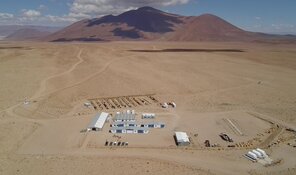The Gold Report: Paolo, what three words would you choose to give our readers a sense of what to expect in the precious metals equity space in 2014?
Paolo Lostritto: Defense, defense and more defense.
TGR: The Vince Lombardi approach.
PL: Even though deflation risk is priced into most of the equities, it's difficult to predict when inflation expectations will start to gain traction. While quantitative easing tapering efforts are being introduced with some signs of economic improvement in the U.S., we believe tapering could reignite deflation fears. The market was reassured after Janet Yellen's nomination as Federal Reserve chair, but the bond yield-to-maturity suggests that deflation risk is still alive and well. There is more work to be done before inflation becomes a bigger concern, and as such, we believe the gold market will remain challenging. The challenge is centered on balance sheet risk in a market where margins are negative, thus resulting in many value traps that are out there right now.
TGR: Earlier this week, I spoke with a U.S.-based analyst who believes that rising wage pressure, higher rent and food prices in the U.S. will lead to a slow climb in inflation in 2014 and beyond. Yet, you are talking about the risk of deflation. Other than bond yield rates, what else tells you that deflation is the bigger risk?
PL: Across the board, commodity prices have been under pressure, suggesting that the risk of deflation is still real. Another data point is the inflation expectations data set compiled by the Cleveland Federal Reserve. Right now, it shows that inflation expectations are muted at best.
"Pilot Gold Inc. is an exploration/development company that offers tremendous value."
We believe we are in a similar environment to the 1974–1976 midcycle correction in gold before the onset of inflation. During that period, gold fell from ~US$200/ounce (~US$200/oz) to ~US$100/oz before higher money velocity generated inflation in the Western world that drove gold to more than US$700/oz. While gold has nearly decreased by a similar percentage since the highs set in 2011, we have yet to see definitive evidence of higher money velocity. This, combined with positive real rates, results in our cautious stance. It is worth noting that if higher inflation were to materialize, it is likely to be driven by emerging markets, which would then begin to export said inflation.
I believe gold could go much higher in the long term, but in the meantime, we've got to take a position that a lower price is quite possible and that balance sheet risk remains high.
TGR: An October 2013 research report from National Bank Financial (NBF) suggests that there is inflation risk when the money multiplier increases beyond a 1:1 ratio. What will keep that ratio below 1:1?
PL: The money multiplier is a crude measure of money velocity. While it demonstrates that both the monetary base and M1 are growing, there has been enough to translate into higher inflation expectations. The government is giving mixed signals. The Fed's policies are reinflationary. Government policies, in contrast, have been emphasizing austerity.
We need to see that the liquidity being provided is actually getting traction and is producing real economic growth. While there are early signs that this is starting to happen, I would like to see how the bond market reprices inflation expectations. We still believe the deflation risk remains high—you need to be defensive.
There are signs that the U.S. economy is turning around. But, our NBF economists don't see inflation in the system, and that's bad for gold. That will change only when the velocity of money starts to improve, leading to better capacity utilization, which translates to higher inflation expectations. It will take time for those signals to align.
TGR: In the event of another collapse, what weapons does the Fed have left?
PL: More money is all we've got left. The Fed can purchase more bonds, which effectively introduces more liquidity, but we would probably see monetary policies that would coincide with fiscal policy to allow for some infrastructure projects. We would want the new liquidity to show up in the real economy, as opposed to the coffers of Tier 1 banks.
TGR: Physical holdings in exchange-traded funds (ETFs) have fallen in lockstep with the gold price. Are Chinese and Indian gold imports enough to sustain the gold price, or push it higher?
"I believe gold could go much higher in the long term, but in the meantime, we've got to take a position that a lower price is quite possible and that balance sheet risk remains high."
PL: About 800 tonnes have sold out of the ETFs, and there have been a similar amount of purchases through Hong Kong into mainland China. Demand in India remains robust, despite elevated import taxes. There also are signs of more smuggling into India. However, we're still dealing with a potential 1,800 tonnes of ETF supply.
The weak gold price is less a function of supply-and-demand and more a function of deflation risk. We see gold as another type of currency. If all the gold mines in the world shut down tomorrow, it would only equate to removing 0.1% of aboveground stocks.
TGR: What's your projected trading range for gold in 2014?
PL: We're using US$1,300/oz to value our stocks. If our worries are confirmed and the bond market starts to signal an increased risk of deflation, we could be dealing with a lower gold price deck.
The average all-in sustaining cost number may be the better number to use. That could drop to US$1,000–1,200/oz.
On the flip side, if we see velocity and inflation expectations start to go up and the real rates go negative again, that fair-value number is probably closer to US$1,600–1,800/oz. This is a very difficult time to predict the gold price.
TGR: When NBF calculates all-in cash costs for gold miners it uses a different definition than the World Gold Council. You omit non-cash remuneration and stockpiles/product inventory write-downs. On all-in sustaining costs, you also omit reclamation and remediation at operating and non-operating sites. Would investors be better served if these definitions were the same across the board?
PL: We, and the World Gold Council, are trying to define the true average cost of the industry. We are roughly in the same ballpark. You mentioned what we exclude, but we also include cash taxes. The World Gold Council excludes cash taxes and interest payments.
Remember, we're tabulating this based on public data. Not every company breaks out its true sustaining capital in a given quarter versus growth capital. We approximate the sustaining capital number by using depreciation, depletion and amortization as a proxy. Of course, it won't be accurate because it uses depreciated data dollars as a proxy, but it's a good start.
TGR: Roughly what percentage of the producers you follow make money at today's level of all-in cash costs or all-in sustaining costs?
PL: From an all-in sustaining cost perspective, the Q3/13 50th percentile is around US$1,050/oz. That means 50% of the industry is losing money, not from a growth perspective, but from a sustaining basis at US$1,050/oz and above. It was US$1,200/oz in Q2/13.
TGR: That's shocking. Does that make you want to look for a different line of work?
PL: We're in the midst of a once-in-a-century event. I believe there are two ways out of it. Scenario one: We have a deflationary recession, also called a depression. Scenario two: We repeat what happened in the 1970s and we inflate our way out. But this time it's on a global scale.
Based on the behavior of the central banks of Japan, the U.K. and the U.S., they seem to be trying to inflate their way out. The question then becomes, when will inflation gain traction?
TGR: A recent NBF research report compared takeover transactions among senior producers, midtier producers, developers and explorers. Where are investors getting the best bang for their buck?
PL: Historic transactions have to be considered in the context of the market at the time. Today's market resembles 2008. One could argue that this is a great time for free cash flow entities to acquire assets. In a market where cash is king, it's all about doing bite-size, tuck-in type acquisitions that allow companies to take advantage of a challenging market.
Structurally, some large companies are set up to mine gold at a rate that Mother Nature cannot support. Deposit discoveries are not the size or frequency that can support them. There's an opportunity for the smaller companies, like B2Gold Corp. (BTG:NYSE; BTO:TSX; B2G:NSX), to acquire good assets that can be developed to create tremendous value when the market turns.
TGR: On net asset value (NAV) and enterprise value per ounce, which of those four spaces provides the best return to investors?
PL: There's a lot of value out there, but investors want to avoid being caught in a value trap. For example, a company may be cheap on a price-to-NAV and price-to-cash flow basis, but it also could have lots of balance sheet risk. If it goes bankrupt before the market turns, investors are caught on the wrong side of the trade, despite the fact that it's great value.
I would rather buy something that generates free cash flow, like a Franco-Nevada Corp. (FNV:TSX; FNV:NYSE) or a Royal Gold Inc. (RGLD:NASDAQ; RGL:TSX). (Royal Gold is covered by Shane Nagle.) "Be defensive" has been our thesis since early 2013. Free cash flow companies will yield, even if this market lasts four more years; the NAV continues to grow. When the market rerates, investors are actually up.
TGR: NBF's Oct. 13 report noted that producer transactions were completed at an average of 1.13 times NAV and $155/oz enterprise value. Senior gold producers were 1.2 times NAV and $125/oz enterprise value. Developers were 0.84 times NAV at $102/oz, and exploration transactions were 1.1 times NAV at $55/oz.
PL: No question, there's tremendous value out there. The questions become: How long does this market last? How does an investor stay solvent? I would buy Franco or Royal Gold, knowing that I'm solvent.
TGR: What is your 2014 investment thesis in the precious metal space?
"There are value propositions out there. Solid management teams will be able to take advantage of this market to drive value in the longer term."
PL: We remain defensive. Our top picks are Franco-Nevada and Royal Gold because they're generating free cash flow yield even at lower gold prices and because we don't know how long this deflation period may last.
For people interested in taking on a little bit more risk we start outlining companies like Yamana Gold Inc. (YRI:TSX; AUY:NYSE; YAU:LSE) and New Gold Inc. (NGD:TSX; NGD:NYSE.MKT). (Yamana and New Gold are covered by Steve Parsons.) Both companies have strong balance sheets and a little bit more leverage to the gold price.
If you really want to look at names that offer some opportunity if gold goes to $1,500/oz, that group includes B2Gold, SEMAFO Inc. (SMF:TSX; SMF:OMX) and a myriad of names that give you that higher torque.
TGR: Let's talk about the royalty plays for a moment. Does Franco-Nevada now transcend mining equities? Is it competing with yield-providing equities outside the mining space?
PL: It's a bit of a hybrid. It's not the same as owning physical gold. It provides some dividend exposure. It also gives investors torque to the actual underlying commodity, which is another good thing.
TGR: Is Franco-Nevada attracting investors that typically wouldn't be in the gold mining space?
PL: People who are sprinkling a bit of exposure to gold in their portfolio feel more comfortable with larger companies. Franco-Nevada is a larger company and is more defensive than some of the pure torque names with exposure to the cost side of the equation.
TGR: What did you make of Franco's deal with Klondex Mines Ltd. (KDX:TSX; KLNDF:OTCBB) of $35 million over five years, or roughly 38,000 oz gold?
PL: That is the type of deal that you can do in this market where you're tucking in an acquisition. There's a discovery value to being in a camp and having exposure.
The real value proposition with owning a company like Franco-Nevada is getting the exploration opportunity without having to use your dollars.
TGR: Are there any milestones ahead for Yamana and New Gold?
PL: We expect New Gold to incorporate the recently acquired Rainy River deposit into its development plan.
Yamana recently made some tuck-in acquisitions. Management is focused on defense, keeping the company's cash costs low and maintaining free cash flow yield.
TGR: In the past, B2Gold's management has developed assets and sold them off. It's currently a junior partner in a couple of Colombian projects. Where is B2Gold's growth coming from?
PL: In the short term, there are two projects: Masbate in the Philippines and the Otjikoto mine in Namibia.
In addition to a great operating team, B2Gold is known for its great geological team. The geological team can find incremental ounces near existing infrastructure, thereby creating value through the drill bit.
TGR: Will B2Gold get to a point where it can compete in the next tier down from the biggest majors, say with Agnico-Eagle Mines Ltd. (AEM:TSX; AEM:NYSE) and Yamana?
PL: I don't see why not. They're all competing for the same growth profile. It becomes a matter of which projects are available, how much they cost and where the opportunity is for incremental value added through the drill bit or reengineering.
TGR: What is SEMAFO up to?
PL: SEMAFO has done a good job of retrenching. It's focusing on higher-grade material—not ounces for ounces' sake, but ounces that provide a better internal rate of return and better margins with the Siou and Fofina discoveries and recent anomalies identified in and around this trend.
SEMAFO has spun off or ceased production at some of its higher-cost mines to focus on locations where the company can get the best bang for the buck.
TGR: Let's shift to silver. The fortunes of South American Silver Corp. (SAC:TSX; SOHAF:OTCBB) are well documented. Are there other small-cap companies with exceptional management teams developing world-class deposits that most investors probably aren't aware of?
PL: We cover several exploration/development companies that offer tremendous value: Lydian International Ltd. (LYD:TSX), Pilot Gold Inc. (PLG:TSX), True Gold Mining Inc. (TGM:TSX.V), Romarco Minerals Inc. (R:TSX) and Mountain Province Diamonds Inc. (MPV:TSX).
"True Gold Mining Inc.'s feasibility study for the Karma project supports a low capital intensive, relatively simple and scalable gold project."
These are phenomenal assets that deserve more attention than they're getting. They will have their day; slow and steady wins the race. For example, True Gold announced the results of the feasibility study for the Karma project, which supports a low capital intensive, relatively simple and scalable gold project. The recent exploration results have also been encouraging and have the potential to add to current mine life. We believe the next catalyst for the company would be approval of exploitation permits and receipt of project financing for construction, which should further derisk the project and help in rerating of the stock.
TGR: Mountain Province is unlike the others in that it is a diamond play. Since when does NBF cover diamonds?
PL: We started covering Mountain Province in 2010. The company just finished permitting, and it has tremendous upside. It looks a lot like Aber Resources back in 2000–2003. Diamonds are a different animal. The commodity price beta is not as high as gold.
TGR: What is the tonnage? The carat grade?
PL: A new feasibility study is due in Q1/14, so all the data out there right now is a bit dated. Basically, Mountain Province is looking to produce approximately 4.5–4.8M carats/year.
TGR: What value are you using per carat?
PL: We're using $130/carat, but it could be as high as $140–145/carat.
Two exceptionally large stones found in the drill core were not included in the valuation. That would suggest a population of special diamonds that could take the average value per carat much higher once in production.
The same thing happened at Aber, where the value of the stones was boosted 15–20% in a larger sample set. There's no guarantee that will happen here, but the data are eerily similar in that regard.
TGR: Do you use a deeper discount rate with diamond equities than gold equities, given that the Ekati and Diavik diamond mines in northern Canada both have run close to 10% below feasibility projections to date?
PL: I used an 8% discount rate when I valued Mountain Province. We will reassess the risk/reward profile using the new feasibility study.
Based on what I know now, I like the name. There may be an opportunity for the company to rerate in the range of 10 to 12 times operating cash flow. That would suggest a stock price, when it's built by 2017, in the range of $13 to $15 per share.
TGR: Do you have a parting thought for investors as we usher in 2014?
PL: It's been a challenging market on multiple fronts. There are a lot of moving parts and it has been frustrating for everybody in the mining space. A lot of exuberance has been flushed out of the system.
Nonetheless, there are good people doing some good things. There are value propositions out there. Solid management teams will be able to take advantage of this market to drive value in the longer term.
TGR: But you're still preaching defense?
PL: Correct.
TGR: Paolo, thanks for your time and insights.
At the time of this interview, Paolo Lostritto was director of mining equity research for National Bank Financial. He has also worked with Wellington West Mining, Scotia Capital and MGI Securities. He holds a Bachelor of Science degree in geological and mineral engineering from the University of Toronto.
Want to read more Gold Report interviews like this? Sign up for our free e-newsletter, and you'll learn when new articles have been published. To see a list of recent interviews with industry analysts and commentators, visit our Streetwise Interviews page.
DISCLOSURE:
1) Brian Sylvester conducted this interview for The Gold Report and provides services to The Gold Report as an independent contractor. He or his family own shares of the following companies mentioned in this interview: None.
2) The following companies mentioned in the interview are sponsors of The Gold Report: Klondex Mines Ltd., Pilot Gold Inc. and True Gold Mining Inc. Franco-Nevada Corp. is not affiliated with The Gold Report. Streetwise Reports does not accept stock in exchange for its services or as sponsorship payment.
3) Paolo Lostritto: I or my family own shares of the following companies mentioned in this interview: None. I personally am or my family is paid by the following companies mentioned in this interview: None. My company has a financial relationship with the following companies mentioned in this interview: None. I was not paid by Streetwise Reports for participating in this interview. Comments and opinions expressed are my own comments and opinions. I had the opportunity to review the interview for accuracy as of the date of the interview and am responsible for the content of the interview.
4) Interviews are edited for clarity. Streetwise Reports does not make editorial comments or change experts' statements without their consent.
5) The interview does not constitute investment advice. Each reader is encouraged to consult with his or her individual financial professional and any action a reader takes as a result of information presented here is his or her own responsibility. By opening this page, each reader accepts and agrees to Streetwise Reports' terms of use and full legal disclaimer.
6) From time to time, Streetwise Reports LLC and its directors, officers, employees or members of their families, as well as persons interviewed for articles and interviews on the site, may have a long or short position in securities mentioned and may make purchases and/or sales of those securities in the open market or otherwise.












































